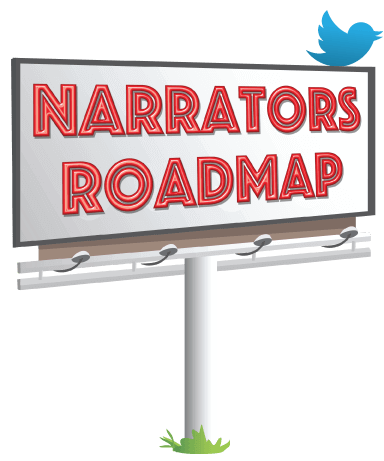You must read the entire book before stepping into the booth. This point is a non-negotiable standard in the industry.
If you don’t know where the story is headed, how can you possibly tell it well?
In her book Audiobook Narrator: The Art of Recording Audio Books, legendary award-winning narrator Barbara Rosenblat, whom AudioFile Magazine compared to Meryl Streep, wrote about the importance of pre-reading the book:
I read the book only once, slowly.
I determine what voices to lend to the various characters as I prep the book.I read the book only once, slowly.
I take the book, sit in my favorite chair with as much quiet as I can surround myself with, and slowly start to pore through the book and allow the characters and the atmosphere and the dramatic arcs to occur to me as I read.
I have to read the book at least once so I know where the characters are going, so I can foreshadow and deliver lines differently depending on what is still to come.
In short, you cannot be true to the author’s intent if you do not read the book before you record. Prep is not wasted time but instead is the crucial element of the job. The more work you can do on the front end leads to a smoother and easier time during the recording process and a better finished product.
Every word in the book has meaning and lends itself to one’s overall interpretation of the text.
In his 21 Targets course, narrator and coach Matthew Lloyd Davies further emphasized that the text is all we have. He said:
There are only the words on the page. There is nowhere else to look! If you look anywhere else, then you’re not telling the story of the book.
Most narrators read a digital copy of the book on their tablet. I’m one of the many pro narrators who uses the iAnnotate app on an iPad for this purpose. The $9.99 cost of the app is a business expense. This app works well with the Apple Pencil and has built-in features to aid in our prep. (I developed a video course on this app for those narrators who have a Member Express Pass. Click here if you’d like to see a sample.) Other popular annotation apps include Notability and Good Reader. You’ll want to experiment to find the one you like best.
Characters
You’ll be making decisions about how to perform the book to realize the author’s intentions, including giving thought to character voices. You need to glean every bit of info about the characters to be able to portray them as real people instead of caricatures.
Narrator and coach Matthew Lloyd Davies noted during my section of his 21 Targets course that we often forget to ask ourselves 2 important questions when deciding how to tell the story:
- “Who is telling this story?”
- “Could I listen to this for 10 hours?”
You may think that you can simply ask the author for character breakdowns and pronunciations. Please do not rely on this lazy approach! As the narrator, you are supposed to be the expert, and as such, prepping the book is a significant part of your job.
Other Considerations
Words not directly related to character development are vitally important for establishing appropriate pacing and tone. They reveal the subtext of the relationships and story arc and drive our interpretations.
You must “read between the lines” and understand the subtext of each scene and how it builds the story arc. You control the surprise for the listener. Otherwise, audiobooks could be recorded by artificial intelligence (AI) instead of actors.
You’ll want to consider diversity, equality, and inclusivity when determining whether you are the best fit for the material.
Reading the book also allows you to check your inner compass. If the manuscript contains sections you find objectionable that you do not wish to perform, the time to cancel a contract is before you have started recording the book.
Author and Publisher Contact
When an author hires you, you can send them a welcome packet that includes your questions, but please realize that it’s not the author’s job to supply you with anything. (For example of a welcome packet, look for my page in the Resources of Audiobook production workflow.)
When a publisher or production house hires you, you may only receive a synopsis. They don’t have the capacity to read every book. They expect the narrator to do thorough prep to make appropriate acting choices based on the author’s intent.
However, you can ask the producer for the book’s Style Sheet. Narrator Natalie Naudus shared that the traditional print publishers create these Style Sheets when editing the book. The audio group may need to request it from the print group, and it may not always be available. Some Style Sheets include more details than others. You won’t know unless you ask for it.
In addition, you should be aware that when you are working with publishers, you should not attempt to contact the author without the publisher’s permission. You would submit any questions about pronunciations and characters to the producer.
As a tangent to that last point about working with publishers, let me add that you should not share any pre-release info on social media without the publisher’s permission.
During your pre-read, do the following things:
1) Read Amazon and Goodreads reviews of your book. They often contain a synopsis of the book which may help you recognize its plot points and themes. Reviewers also frequently summarize the characters’ traits and sometimes comment that the book and/or characters reminds them of a TV show or movie.
2) Create a pronunciation list and note any words you don’t know how to say or only think you know how to say, including names of cities, real people, brands, technical jargon, and foreign phrases. Incorrect pronunciations are a sure-fire way to make a listener drop out of the story! (I encourage you to read narrator and director Kimberly Wetherell’s Twitter thread about the audiobook production process in response to a listener who complained about pronunciation errors.)
You may need to consult several sources in order to find an authoritative answer. The first pronunciation listed in a dictionary may not be correct for your book or your character. Your decision about the correct usage is based on the context, author’s style, time period, socio-economic background of the character, and dialect.
Also, names of cities, towns, and streets should be pronounced the way the locals say it. For instance, Cairo, GA, Cairo, IL, and Cairo, Egypt have 3 different pronunciations.
Some narrators prefer to enter add their pronunciation research to the text. I advise you to enter all of your pronunciation research in a separate document so that you can easily share it with your editor and proofer, and reuse it on later books, especially if you are doing a book in a series. Some people use Excel. I use Evernote as you can see in this video.
Finishing your pronunciation research before you are in the booth will make you a more efficient narrator and enable you to maintain the flow of the narrative. You’ll find some pronunciation resources listed in the Welcome Center.
3) Take notes about anything descriptive about fiction characters, including what the character says about himself and what others say about him. For instance, you may learn deep into the book that they have a specific accent. I discuss this step more and include an example of one of my character dossiers in this article. You’ll also find some helpful tips about character development in this Backstage article and tips for committing to your characters in this one written by narrator Elise Arsenault.
If you have permission to contact the author, you could ask them for any background material they can share with you, such as character profiles, pronunciations (especially helpful for sci-fi/fantasy books with invented places and species), or their ideal Hollywood casting. Narrator Joel Leslie describes his character questionnaire in this article.
Some people find it helpful to highlight each character’s dialogue in a different color or write initials in the margin so that you know who is speaking.
It may help you to highlight or underline descriptors or “stage” directions, such as “he whispered” or “she said in a trembling voice” as narrator Suzy Jackson demonstrates at 1:31 in this video.
You may also find it useful to map out relationships between characters and/or the characters in a scene. To that end, narrator Rachel Leblang offers this suggestion:
I always block some time out after I finish reading a book for prep to sit down and hand write out the main characters and what lasting impressions I had of them: characteristics, relationships, story arcs, etc. To see what really stuck with me about each person after reading the whole thing.
Whether you decide on a voice before you record or during the session, save a snippet of the voice some place where you can easily reference it later in the session. You might save it on your computer with you DAW or on your phone’s voice recorder. You’ll be able to hear it and get back into character whenever you need it.
Site members can watch watch module 12 of my iAnnotate Video Course in which I show how to store and share voice clips within iAnnotate.
4) For non-fiction books, you need to perform with the passion of the author even though you will probably lack their expertise. You would do well to follow narrator and coach Sean Pratt’s guidance in his 2-part mini-masterclass about non-fiction prep on VoiceOverXtra:
Part One
Part Two
You’ll also want to refer to Sean’s article about the 4 voices of non-fiction.
Case Studies
Audiobook narrators always hear the anecdotal story about the narrator who didn’t do any prep and learned when recording page 300 that the main character had a specific accent. This narrator then had to re-record all of that character’s lines in the book.
I want to share 2 actual case studies that illustrate the importance of thoroughly prepping the entire book before starting to record.
1. Harold and Maude by Colin Higgins, narrated by Barbara Rosenblat
A listener on Audible commented in her audiobook review:
I did not care for Barbara Rosenblat’s use of a German dialect for Maude. Again, Ruth Gordon’s portrayal of the sweet, seemingly naive and fun loving Maude appealed to me much more.
The narrator can’t depend on or even consider a movie actor’s interpretation of the text and must come up with her own interpretation of the author’s words.
In this book, the author steered Rosenblat to a German accent with these lines:
p. 16 The narrative tells us, “She spoke with a slight European accent.”
p. 29 Maude says, “I don’t speak Dutch. German, French, English, some Spanish, some Italian, and a little Japanese.” I would think that most people would list their native language first.
p. 58 Maude says, “When I was a little girl in Vienna…” and [she met her husband when she] “knocked off his hat. With a snowball in the Volksgarten.” Note that German is the official language of Austria.
p. 72 The narrative states “She had taught Frederick to play marbles when they were in hiding after the Anschluss.”
2. Bamie: Theodore Roosevelt’s Remarkable Sister by Lilian Rixey, narrated by Karen Commins
I confess! Even with my experience, I became one with the anecdotal narrator though not because of lack of prep. Instead of discovering a necessary accent late in the book, I learned a critical pronunciation, which I never would have thought would be somehow revealed in a text.
TR’s sister Anna “Bamie” Roosevelt married a man with the last name of Cowles. I didn’t know whether it was pronounced to rhyme with bowls (long ō) or howls (dipthong) and couldn’t find it in during my pronunciation research.
I needed to start recording on a certain day to meet my deadline. I had read and prepped most — but not all — of the 303 pages in the book.
Since I still hadn’t discovered how to pronounce Cowles, we called an organization dedicated to the study and legacy of Theodore Roosevelt and asked them. The person confidently said the name rhymes with howls.
You can’t imagine my dismay when I read aloud on page 279 this “rhymed toast” in Bamie’s guest book written by her sister Corinne, who certainly would have known how the name was pronounced:
To Admiral and Mrs. Cowles
(Magnetic pair of sunlit souls!)
I did what I should have done at the outset — I combed through obituaries, found a surviving family member, and contacted that person to ask the correct pronunciation. I had to re-record about 150 instances of the name! I was just glad I could make the edits before sending the book to the editor!
Other resources on this topic:
- I found The Art of Reading audio course and accompanying guide to be extremely useful in analyzing a book’s structure and author’s style in depth, which helps us to give a more nuanced read. Professor Timothy Spurgin’s discussion of the type of narrators’ voices in the text is invaluable! Note that the presenter is not a professional narrator, so he stumbles over his words a lot in these lectures.
- APA members will find at least 2 past webinars on script prep under the Resources/Webinars menu option after logging in to audiopub.org.
- Star narrator Katherine Kellgren was well-known for her extensive prep. Sadly, she is no longer with us, but you can learn much about her process from her interviews here and here.
- Grammy-winning producer and director Paul Alan Ruben describes:
- using the prep process to connect emotionally to the text in this article
- how the text gives us actable clues in this article
- Award-winning narrator Ann Richardson wrote a comprehensive article about prep for VoiceOverXtra that includes guides for fiction and non-fiction books.
- Award-winning narrator Joel Leslie Froomkin takes you behind the scenes of his prep process in this article. He also shows how to use reviews before you audition and markup your book during prep in this video.
- AudioFile Golden Voice Michael Crouch describes his process for prep and character delineation in this interview.
- Narrator Dawn Harvey shares excellent tips about prep in her article on VoiceOverXtra.
- Narrator Heidi Rew offers her approach to prep using a spreadsheet in this article.
- Narrator Matt Godfrey discusses his thought process and actions during prep and recording sessions in this in-depth article.
- ACX University created this video on audiobook prep.
- Several narrators offered good preparatory tips, including how to maintain consistency between recording sessions, in this article.
- Author and narrator CC Hogan shares here how he prepares the script for recording.
- Narrator Ann Richardson described skills needed by a good book-preparer on her blog.
- Award-winning narrator Sean Pratt describes the “colors” of the paragraph in non-fiction books and shares a few pages of mark-up in this article.
- This article illustrates that every word has meaning, and a single word can shape an actor’s entire performance. Thanks to narrator Michelle Lee for the find.
- Prep tips from several narrators are included in this Voices.com article.
- Work with a coach from the Coaches Directory and check out the list of downloadable courses in the Welcome Center.








